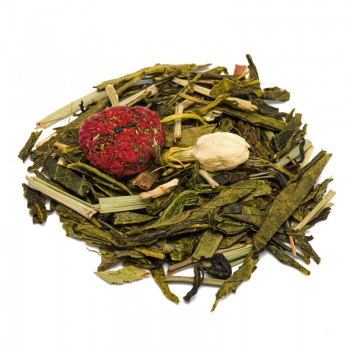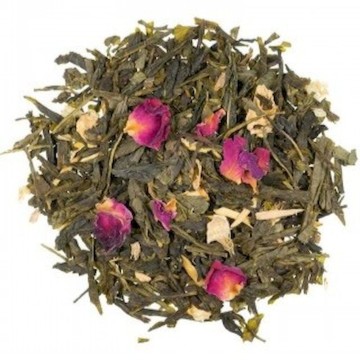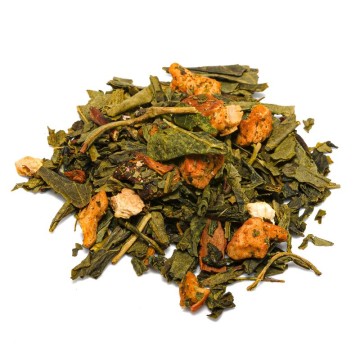Green tea Raspberry and Jasmine
This infusion includes both the taste of jasmine tea and Sencha, enriching them with other beneficial and aromatic components. A fragrant and soft green tea, which comes from an ancient Chinese tradition. The tea was dried with the flowers of the jasmine plant, to assimilate its fragrance, and could be an excellent drink for meals. In this version, green tea combines raspberry and jasmine to create an even more fragrant and sweet combination, also enhanced by notes of lemongrass, passion flower and bamboo leaves. Also includes Jasmine Dragon Pearls, striking pearls made from two green tea leaves and an unopened jasmine bud. A beautiful blend of fruit and flowers creates a green tea that uplifts and delights, cold or hot.
Properties and benefits
This jasmine and raspberry tea is made from green tea leaves, so it makes available the health benefits that you get from drinking green tea. In addition, it gives natural calming qualities thanks to other ingredients. The tea contains caffeine and L-theanine in a balanced way. Substances that can help concentration and attention, giving energy without providing stress. A green tea that reduces fatigue by avoiding the effects of excessive caffeine. Jasmine and raspberry tea enhances this potential, with a relaxing power due to its wonderful aroma. It is used as a natural stress reliever. The combination of jasmine and green tea is rich in antioxidants, known to help relieve anxiety and stress. Jasmine contains substances that act on the senses through the scent, with the result of calming the nerves, reducing anxiety and promoting rest. To this is added the property of the raspberry, which contains substances beneficial to the nervous system, and the passion flower has a natural sedative action. Therefore, for those who have difficulty lying down and falling asleep, raspberry and jasmine tea before going to bed gives a soothing effect.
Jasmine tea is rich in plant compounds known as polyphenols, catechins, antioxidants which protect our cells from free radicals, with anti-aging functions and useful for the well-being of the skin. Raspberry is also a fruit rich in antioxidants, and counteracts aging thanks to the antioxidants and vitamin C present in the fruit. In addition, it enhances the purifying effects of green tea by improving diuresis, intestinal transit and counteracting constipation. One catechin in green tea is epigallocatechin gallate (EGCG), linked to benefits for speeding up metabolism, burning excess fat, and controlling blood sugar and lipids. Furthermore, the catechins help the well-being of the oral cavity, while the aromas of raspberry and jasmine green tea give a perfumed breath.
Origins and History of cultivation
The history of jasmine tea goes back many centuries, and it represents the base of the infusion to which raspberry and other ingredients are added. In particular, the Jasmine Dragon Pearls are based on the legend about the power of a magical dragon. The story of a precious pearl, handed down for generations in Chinese families even with different versions. The dragon appeared in a dream to an old man, who asked how to cure his daughter's illness. The dragon reveals to him a secret method: to combine a flower from the far west with high mountain tea buds, harvested in spring. The old man embarked on the journey, created his miraculous infusion and the little girl was cured. In another story, a poor brother and sister lived in a small village in Fuzhou, Fujian Province (the homeland of jasmine tea). When the brother fell ill, an old woman told her sister about the magical dragon, which could heal him. In this case, the dragon was found with beautiful pearls around its neck, from whose drops tea bushes were born, next to some jasmine. From gathering the leaves and flowers, she created dragon-like beads—perfect for the brew that would heal her brother. In reality, the production of this tea is a demanding process, because the buds and leaves of the tea are harvested in spring, then dried and stored in a cool place. Until the jasmine flowers bloom, in June and in the evening.
These are collected and mixed with dried tea, left to rest for about five hours. Afterwards, the flowers are removed and the tea is left to dry for a few days. This process of perfuming the tea is repeated with the fresh flowers at least five to six times, producing an extraordinary tea in over a month's work. The fragrant green leaves of jasmine are then rolled to createare some pearls. Each dragon pearl requires about four kilos of jasmine flowers, but it is sure to disperse all its aroma in the water! Flowers of common jasmine (Jasminum officinale) or jasmine of arabia (Jasminum sambac) can be used. The other ingredients, such as raspberry and passion flower, are designed to create an even more intense and fragrant infusion.
Plant and flowers
Camellia sinensis is the tea plant, a perennial tree of the Theaceae family. It can grow up to 9 meters but is usually pruned to a height of 1.2 meters to facilitate hand-picking of the leaves. The lanceolate or elliptical leaves are green and about 5-6 cm long. Gives solitary white or cream-colored flowers, and a capsule fruit, in which a single seed is found. Jasminum L. or jasmine is famous for its fragrance, and the plant appears in several species (about 200) and varieties. It is a genus of plants belonging to the Oleaceae family. Many are summer-flowering climbers, while there are also houseplants and the winter jasmine variety with an unscented yellow bloom. Jasmine flowers are small and starry, tending towards white or pale pink.
Most jasmines are climbers up to 6 meters, and some grow as shrubs. The fruit of the raspberry comes from the plant species Rubus idaeus (red raspberry) and Rubus occidentalis (black raspberry). The plants have biennial stems, called canes, which grow in one year and produce fruit in the next. The branches may have thorns, while giving white or pink flowers. After the plant has been pollinated, an aggregate berry is produced, which we consider the raspberry. It is made up of numerous drupes held together in the fruit.
Nutritional values of Raspberry and Jasmine Green Tea
This tea contains some antioxidant polyphenols including EGCG Epigallocatechin gallate, and the amino acid L-theanine and alkaloids (caffeine / theine). Furthermore, it makes available substances with a calming effect such as linalool, and the antioxidants anthocyanins. It has quantities of vitamin C and B vitamins (thiamine, riboflavin, niacin). How to prepare raspberry and jasmine green tea for infusion The tea is obtained by placing about 3-5 grams of the infusion preparation in a cup (250 ml) with water at 80 °C. Leave to infuse for 2 to 3 minutes, before drinking the raspberry and jasmine green tea infusion.
Raspberry and Jasmine green tea: side effects and contraindications
Although green tea has no particular contraindications, it is advisable to respect the recommended doses, to prevent the caffeine contained from causing undesirable effects. Side effects of ingesting too much caffeine include restlessness, anxiety, nervousness, stomach problems, rapid heartbeat. Jasmine tea contains catechins, which in high quantities could reduce the body's ability to absorb iron from food; for those suffering from anemia and iron deficiency it is good to pay attention to the consumption of green tea. Caution is also advised for pregnant and breastfeeding women.









 No reward points for this product.
No reward points for this product.




![Green tea Jasmine and jasmine [Natura d'Oriente]](https://www.naturadoriente.com/3373-home_default/green-tea-jasmine-and-jasmine-.jpg)





![green tea roasted almond [Natura d'Oriente]](https://www.naturadoriente.com/3366-home_default/green-tea-with-roasted-almonds.jpg)

![Green Tea Sencha Kombucha [Natura d'Oriente]](https://www.naturadoriente.com/3380-home_default/-green-tea-sencha-kombucha-.jpg)


